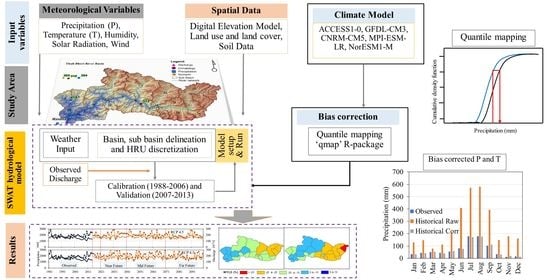Impact of Climate Change on the Streamflow Modulated by Changes in Precipitation and Temperature in the North Latitude Watershed of Nepal
Abstract
1. Introduction
2. Materials and Methods
2.1. Materials
2.2. Methods
2.2.1. Bias Correction of Precipitation and Temperature
2.2.2. Development of SWAT Hydrological Model
2.3. Study Area
3. Results
3.1. Statistical Performance of Bias-Corrected Precipitation and Temperature
3.2. Projection and Changes in Monthly Precipitation
3.3. Projection and Changes in Monthly Temperature
3.4. Calibration and Validation of SWAT Hydrological Model
3.5. Projection and Changes in Monthly Streamflow
3.6. Projection and Changes in Precipitation Pattern for Future Time Windows
3.7. Projection and Changes in Temperature Pattern for Future Time Windows
3.8. Projection and Changes in Streamflow Pattern for Future Time Windows
3.9. Relation between Precipitation, Temperature, and Streamflow
4. Discussion
4.1. Projection and Changes in Precipitation, Temperature, and Streamflow
4.2. Impact of Climate Change on the Basin Water Yield
5. Conclusions
Supplementary Materials
Author Contributions
Funding
Institutional Review Board Statement
Informed Consent Statement
Data Availability Statement
Acknowledgments
Conflicts of Interest
References
- Pachauri, R.K.; Allen, M.R.; Barros, V.R.; Broome, J.; Cramer, W.; Christ, R.; Church, J.A.; Clarke, L.; Dahe, Q.; Dasgupta, P.; et al. Climate Change 2014: Synthesis Report. Contribution of Working Groups I, II and III to the Fifth Assessment Report of the IntergovernMental Panel on Climate Change; IPCC: Geneva, Switzerland, 2014; p. 151. [Google Scholar]
- Jeuland, M.; Harshadeep, N.; Escurra, J.; Blackmore, D.; Sadoff, C. Implications of climate change for water resources development in the Ganges basin. Water Policy 2013, 15, 26–50. [Google Scholar] [CrossRef]
- Taye, M.T.; Willems, P.; Block, P. Implications of climate change on hydrological extremes in the Blue Nile basin: A review. J. Hydrol. Reg. Stud. 2015, 4, 280–293. [Google Scholar] [CrossRef]
- Aryal, A.; Shrestha, S.; Babel, M.S. Quantifying the sources of uncertainty in an ensemble of hydrological climate-impact projections. Theor. Appl. Climatol. 2019, 135, 193–209. [Google Scholar] [CrossRef]
- Pandey, V.P.; Dhaubanjar, S.; Bharati, L.; Thapa, B.R. Spatio-temporal distribution of water availability in Karnali-Mohana Basin, Western Nepal: Climate change impact assessment (Part-B). J. Hydrol. Reg. Stud. 2020, 29, 100691. [Google Scholar] [CrossRef]
- Arheimer, B.; Lindström, G. Climate impact on floods: Changes in high flows in Sweden in the past and the future (1911–2100). Hydrol. Earth Syst. Sci. 2015, 19, 771–784. [Google Scholar] [CrossRef]
- Kalnay, E.; Cai, M. Impact of urbanization and land-use change on climate. Nature 2003, 423, 528–531. [Google Scholar] [CrossRef]
- Collins, M.; Knutti, R.; Arblaster, J.; Dufresne, J.L.; Fichefet, T.; Friedlingstein, P.; Gao, X.; Gutowski, W.J.; Johns, T.; Krinne, G.; et al. Long-term climate change: Projections, commitments and irreversibility. In Climate Change 2013-The Physical Science Basis: Contribution of Working Group I to the Fifth Assessment Report of the Intergovernmental Panel on Climate Change; Cambridge University Press: Cambridge, UK; New York, NY, USA, 2013; pp. 1029–1136. [Google Scholar]
- Meehl, G.A.; Stocker, T.F.; Collins, W.D.; Friedlingstein, P.; Gaye, A.T.; Gregory, J.M.; Kitoh, A.; Knutti, R.; Murphy, J.M.; Noda, A.; et al. Global Climate Projections. In Climate Change 2007: The Physical Science Basis. Contribution of Working Group I to the Fourth Assessment Report of the Intergovernmental Panel on Climate Change; Solomon, S.D., Qin, M., Manning, Z., Chen, M., Marquis, K.B., Averyt, M., Tignor, A.M., Miller, H.L., Eds.; Cambridge University Press: Cambridge, UK; New York, NY, USA, 2007; Available online: https://www.ipcc.ch/site/assets/uploads/2018/02/ar4-wg1-chapter10-1.pdf (accessed on 23 May 2021).
- Kirtman, B.; Power, S.B.; Adedoyin, A.J.; Boer, G.J.; Bojariu, R.; Camilloni, I.; Doblas-Reyes, F.J.; Fiore, A.M.; Kimoto, M.; Meehl, G.A.; et al. Near-Term Climate Change: Projections and Predictability; Cambridge University Press: Cambridge, UK; New York, NY, USA, 2013. [Google Scholar]
- Xin, X.; Zhang, L.; Zhang, J.; Wu, T.; Fang, Y. Climate change projections over East Asia with BCC_CSM1. 1 climate model under RCP scenarios. J. Meteorol. Soc. Jpn. Ser. II 2013, 91, 413–429. [Google Scholar] [CrossRef]
- Tadross, M.; Jack, C.; Hewitson, B. On RCM-based projections of change in southern African summer climate. Geophys. Res. Lett. 2005, 32, 2393–2413. [Google Scholar] [CrossRef]
- Khadka, D.; Pathak, D. Climate change projection for the Marsyangdi river basin, Nepal using statistical downscaling of GCM and its implications in geodisasters. Geoenviron. Disasters 2016, 3, 1–15. [Google Scholar] [CrossRef]
- Devkota, L.P.; Gyawali, D.R. Impacts of climate change on hydrological regime and water resources management of the Koshi River Basin, Nepal. J. Hydrol. Reg. Stud. 2015, 4, 502–515. [Google Scholar] [CrossRef]
- Kurihara, K.; Ishihara, K.; Sasaki, H.; Fukuyama, Y.; Saitou, H.; Takayabu, I.; Murazaki, K.; Sato, Y.; Yukimoto, S.; Noda, A. Projection of climatic change over Japan due to global warming by high-resolution regional climate model in MRI. Sola 2005, 1, 97–100. [Google Scholar] [CrossRef][Green Version]
- Dahal, P.; Shrestha, M.L.; Panthi, J.; Pradhananga, D. Modeling the future impacts of climate change on water availability in the Karnali River Basin of Nepal Himalaya. Environ. Res. 2020, 185, 109430. [Google Scholar] [CrossRef]
- Shrestha, S.; Shrestha, M.; Babel, M.S. Modelling the potential impacts of climate change on hydrology and water resources in the Indrawati River Basin, Nepal. Environ. Earth Sci. 2016, 75, 1–13. [Google Scholar] [CrossRef]
- Bajracharya, A.R.; Bajracharya, S.R.; Shrestha, A.B.; Maharjan, S.B. Climate change impact assessment on the hydrological regime of the Kaligandaki Basin, Nepal. Sci. Total Environ. 2018, 625, 837–848. [Google Scholar] [CrossRef]
- Mishra, Y.; Nakamura, T.; Babel, M.S.; Ninsawat, S.; Ochi, S. Impact of climate change on water resources of the Bheri River Basin, Nepal. Water 2018, 10, 220. [Google Scholar] [CrossRef]
- Oki, T.; Agata, Y.; Kanae, S.; Saruhashi, T.; Yang, D.W.; Musiake, K. Global assessment of current water resources using total runoff integrating pathways. Hydrol. Sci. J. 2001, 46, 983–995. [Google Scholar] [CrossRef]
- Hanasaki, N.; Fujimori, S.; Yamamoto, T.; Yoshikawa, S.; Masaki, Y.; Hijioka, Y.; Kainuma, M.; Kanamori, Y.; Masui, T.; Takahashi, K.; et al. A global water scarcity assessment under shared socio-economic pathways–Part 2: Water availability and scarcity. Hydrol. Earth Syst. Sci. 2013, 17, 2393–2413. [Google Scholar] [CrossRef]
- Guan, X.; Zhang, J.; Elmahdi, A.; Li, X.; Liu, J.; Liu, Y.; Jin, J.; Liu, Y.; Bao, Z.; Liu, C.; et al. The Capacity of the Hydrological Modeling for Water Resource Assessment under the Changing Environment in Semi-Arid River Basins in China. Water 2019, 11, 1328. [Google Scholar] [CrossRef]
- Phan, T.T.H.; Sunada, K.; Oishi, S.; Sakamoto, Y. River streamflow in the Kone River basin (Central Vietnam) under climate change by applying the BTOPMC distributed hydrological model. J. Water Clim. Chang. 2010, 1, 269–279. [Google Scholar] [CrossRef][Green Version]
- Nazari-Sharabian, M.; Taheriyoun, M.; Ahmad, S.; Karakouzian, M.; Ahmadi, A. Water quality modeling of Mahabad Dam watershed–reservoir system under climate change conditions, using SWAT and system dynamics. Water 2019, 11, 394. [Google Scholar] [CrossRef]
- Arnold, J.G.; Srinivasan, R.; Muttiah, R.S.; Williams, J.R. Large area hydrologic modeling and assessment part I: Model development 1. JAWRA 1998, 34, 73–89. [Google Scholar] [CrossRef]
- Arnold, J.G.; Moriasi, D.N.; Gassman, P.W.; Abbaspour, K.C.; White, M.J.; Srinivasan, R.; Santhi, C.; Harmel, R.D.; Van Griensven, A.; Van Liew, M.W.; et al. SWAT: Model use, calibration, and validation. Trans. ASABE 2012, 55, 1491–1508. [Google Scholar] [CrossRef]
- Cuceloglu, G.; Abbaspour, K.C.; Ozturk, I. Assessing the water-resources potential of Istanbul by using a soil and water assessment tool (SWAT) hydrological model. Water 2017, 9, 814. [Google Scholar] [CrossRef]
- Abbaspour, K.C.; Rouholahnejad, E.; Vaghefi, B.; Srinivasan, R.; Yang, H.; Kløve, B. A continental-scale hydrology and water quality model for Europe: Calibration and uncertainty of a high-resolution large-scale SWAT model. J. Hydrol. 2015, 524, 733–752. [Google Scholar] [CrossRef]
- Dhami, B.; Himanshu, S.K.; Pandey, A.; Gautam, A.K. Evaluation of the SWAT model for water balance study of a mountainous snowfed river basin of Nepal. Environ. Earth Sci. 2018, 77, 1–20. [Google Scholar] [CrossRef]
- Bhatta, B.; Shrestha, S.; Shrestha, P.K.; Talchabhadel, R. Modelling the impact of past and future emission scenarios on streamflow in a highly mountainous watershed: A case study in the West Seti River Basin, Nepal. Sci. Total Environ. 2020, 740, 140156. [Google Scholar] [CrossRef]
- Pokhrel, B.K. Impact of land use change on flow and sediment yields in the Khokana Outlet of the Bagmati River, Kathmandu, Nepal. Hydrology 2018, 5, 22. [Google Scholar] [CrossRef]
- Yu, M.; Chen, X.; Li, L.; Bao, A.; De la Paix, M.J. Streamflow simulation by SWAT using different precipitation sources in large arid basins with scarce rain gauges. Water Resour. Manag. 2011, 25, 2669–2681. [Google Scholar] [CrossRef]
- Neupane, S.N.; Pandey, A. Hydrological Modeling of West Rapti River Basin of Nepal Using SWAT Model. In Water Management and Water Governance; Pandey, A., Mishra, S., Kansal, M., Singh, R., Singh, V., Eds.; Springer International Publishing: Cham, Switzerland, 2021; Volume 96, pp. 279–302. [Google Scholar]
- Luo, P.; Takara, K.; He, B.; Cao, W.; Yamashiki, Y.; Nover, D. Calibration and uncertainty analysis of SWAT model in a Japanese river catchment. J. Jpn. Soc. Civ. Eng. Ser. B1 Hydraul. Eng. 2011, 67, I_61–I_66. [Google Scholar] [CrossRef]
- Teutschbein, C.; Seibert, J. Bias correction of regional climate model simulations for hydrological climate-change impact studies: Review and evaluation of different methods. J. Hydrol. 2012, 456, 12–29. [Google Scholar] [CrossRef]
- Shrestha, M.; Acharya, S.C.; Shrestha, P.K. Bias correction of climate models for hydrological modelling–are simple methods still useful? Meteorol. Appl. 2017, 24, 531–539. [Google Scholar] [CrossRef]
- Government of Nepal; Ministry of Energy, Water Resources and Irrigation; Department of Water Resources and Irrigation; Bheri Babai Diversion Multipurpose Project. Strategic Plan of BBDMP. Available online: https://www.bbdmp.gov.np/ (accessed on 23 May 2021).
- Singh, S.; Mall, R.K.; Dadich, J.; Verma, S.; Singh, J.V.; Gupta, A. Evaluation of CORDEX-South Asia regional climate models for heat wave simulations over India. Atmos. Res. 2021, 248, 105228. [Google Scholar] [CrossRef]
- Uddin, K.; Shrestha, H.L.; Murthy, M.S.R.; Bajracharya, B.; Shrestha, B.; Gilani, H.; Pradhan, S.; Dangol, B. Development of 2010 national land cover database for the Nepal. J. Environ. Manag. 2015, 148, 82–90. [Google Scholar] [CrossRef]
- Dijkshoorn, J.A.; Huting, J.R.M. Soil and Terrain Database for Nepal (1.1 Million); No. 2009/01; ISRIC-World Soil Information: Wageningen, The Netherlands, 2009. [Google Scholar]
- Ayugi, B.; Tan, G.; Ruoyun, N.; Babaousmail, H.; Ojara, M.; Wido, H.; Ongoma, V. Quantile Mapping Bias Correction on Rossby Centre Regional Climate Models for Precipitation Analysis over Kenya, East Africa. Water 2020, 12, 801. [Google Scholar] [CrossRef]
- Moriasi, D.N.; Arnold, J.G.; Van Liew, M.W.; Bingner, R.L.; Harmel, R.D.; Veith, T.L. Model Evaluation Guidelines for Systematic Quantification of Accuracy in Watershed Simulations. Trans. ASABE 2007, 50, 885–900. [Google Scholar] [CrossRef]
- Akter, S.; Howladar, M.F.; Ahmed, Z.; Chowdhury, T.R. The precipitation and streamflow trends of Surma River area in North-eastern part of Bangladesh: An approach for understanding the impacts of climatic change. Environ. Syst. Res. 2019, 8, 1–12. [Google Scholar] [CrossRef]
- Hu, L.; Peng, D.; Tang, S.; Xiao, Y.; Chen, H. Impact of climate change on hydro-climatic variables in Xiangjiang River basin, China. In Proceedings of the 2011 International Symposium on Water Resource and Environmental Protection, Xi’an, China, 20–22 May 2011; Volume 4, pp. 2559–2562. [Google Scholar]
- Talchabhadel, R.; Aryal, A.; Kawaike, K.; Yamanoi, K.; Nakagawa, H.; Bhatta, B.; Karki, S.; Thapa, B.R. Evaluation of precipitation elasticity using precipitation data from ground and satellite-based estimates and watershed modeling in Western Nepal. J. Hydrol. Reg. Stud. 2021, 33, 100768. [Google Scholar] [CrossRef]
- Perera, E.D.P.; Hiroe, A.; Shrestha, D.; Fukami, K.; Basnyat, D.B.; Gautam, S.; Hasegawa, A.; Uenoyama, T.; Tanaka, S. Community-based flood damage assessment approach for lower West Rapti River basin in Nepal under the impact of climate change. Nat. Hazards 2015, 75, 669–699. [Google Scholar] [CrossRef]
- Shrestha, A.B.; Agrawal, N.K.; Alfthan, B.; Bajracharya, S.R.; Maréchal, J.; Oort, B.V. The Himalayan Climate and Water Atlas: Impact of Climate Change on Water Resources in Five of Asia’s Major River Basins; ICIMOD, GRID-Arendal and CICERO: Kathmandu, Nepal, 2015. [Google Scholar]
- Nepal, S. Impacts of climate change on the hydrological regime of the Koshi river basin in the Himalayan region. J. Hydro-Environ. Res. 2016, 10, 76–89. [Google Scholar] [CrossRef]
- Thapa, B.R.; Ishidaira, H.; Pandey, V.P.; Shakya, N.M. A multi-model approach for analyzing water balance dynamics in Kathmandu Valley, Nepal. J. Hydrol. Reg. Stud. 2017, 9, 149–162. [Google Scholar] [CrossRef]
- Khatakho, R.; Talchabhadel, R.; Thapa, B.R. Evaluation of different precipitation inputs on streamflow simulation in Himalayan River Basin. J. Hydrol. 2021, 599, 126390. [Google Scholar] [CrossRef]
- Schewe, J.; Heinke, J.; Gerten, D.; Haddeland, I.; Arnell, N.W.; Clark, D.B.; Dankers, R.; Eisner, S.; Fekete, B.M.; Colón-González, F.J.; et al. Multimodel assessment of water scarcity under climate change. PNAS 2014, 111, 3245–3250. [Google Scholar] [CrossRef] [PubMed]
- Liuzzo, L.; Noto, L.V.; Arnone, E.; Caracciolo, D.; La Loggia, G. Modifications in water resources availability under climate changes: A case study in a Sicilian Basin. Water Resour. Manag. 2015, 29, 1117–1135. [Google Scholar] [CrossRef]
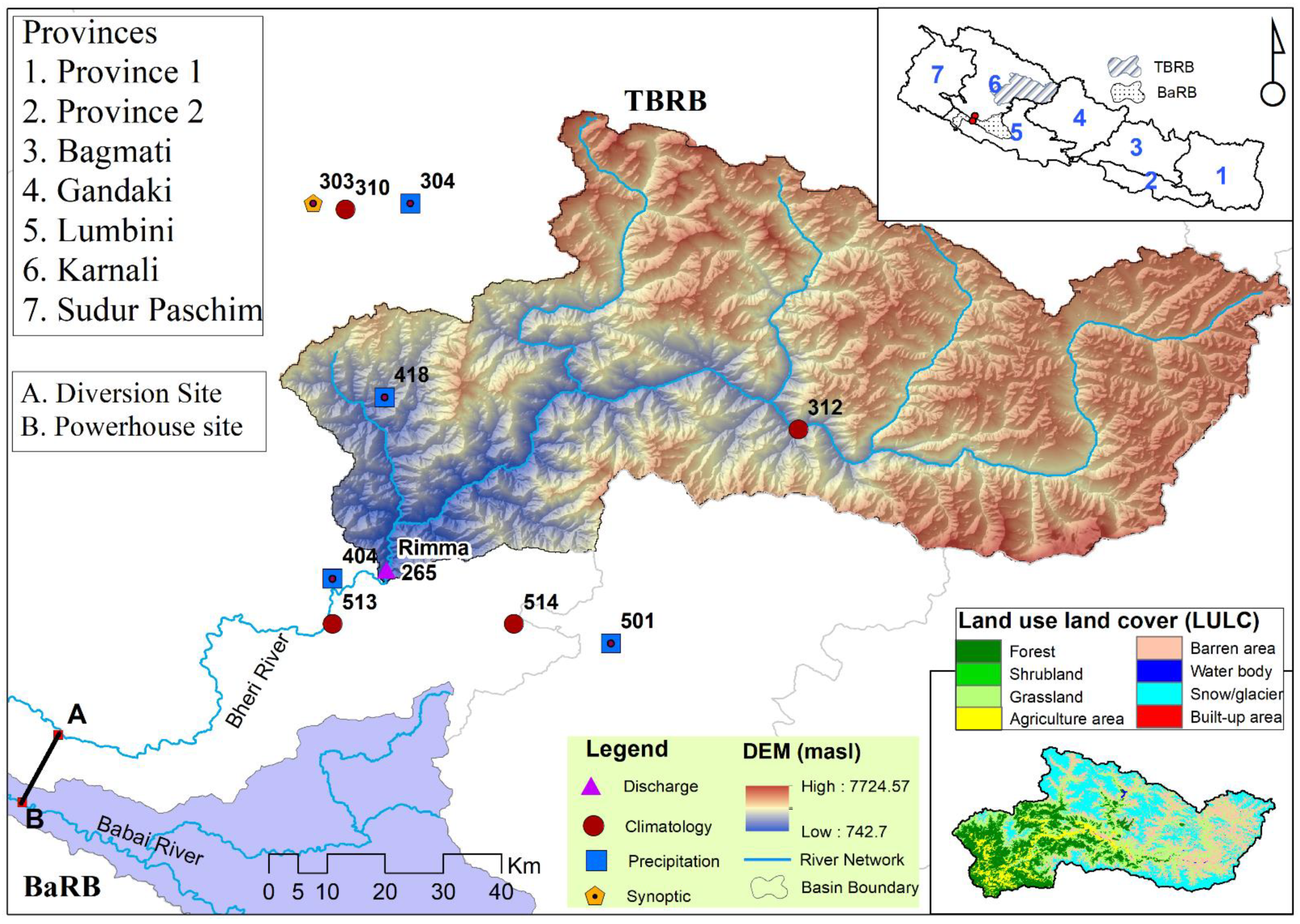
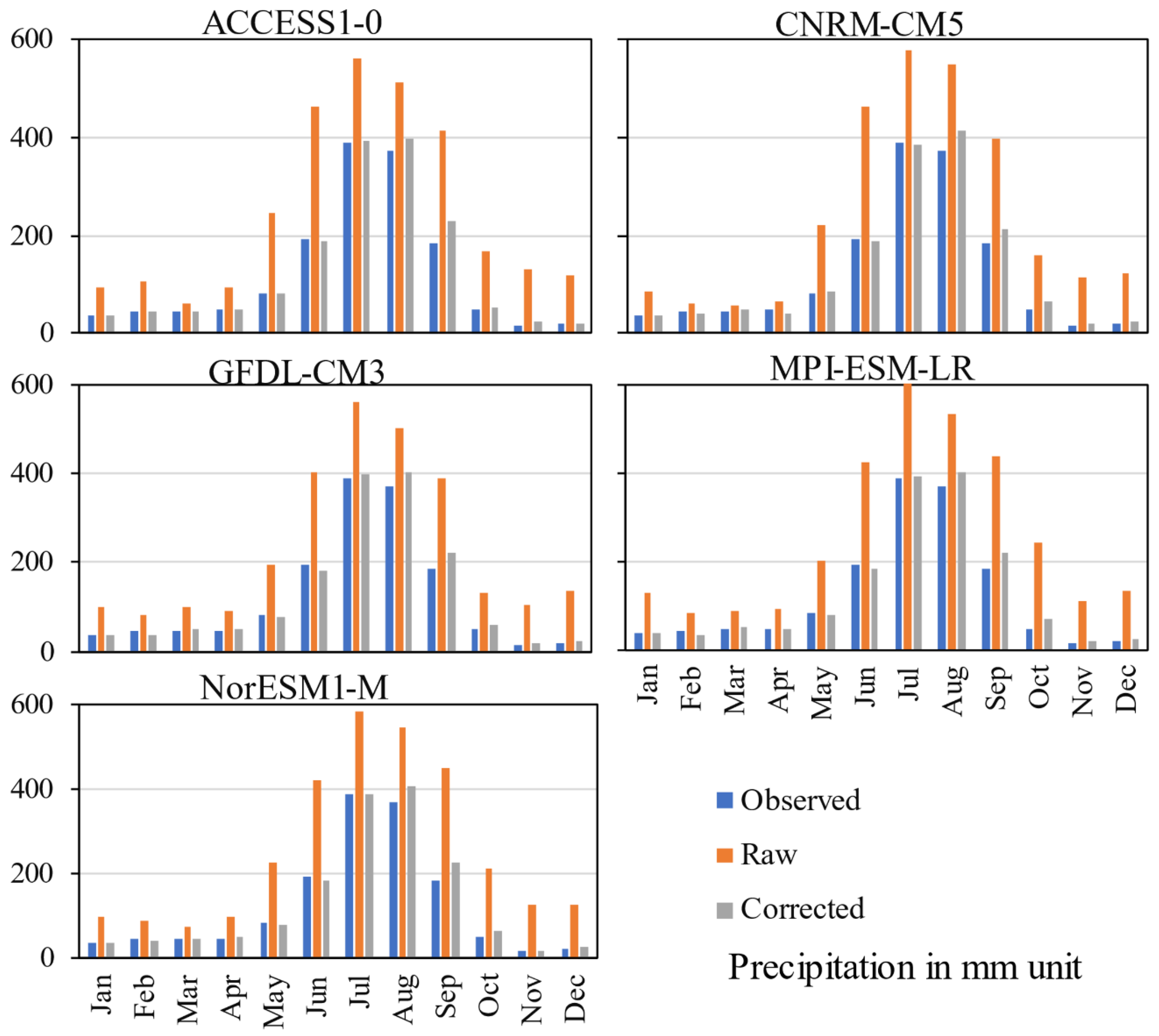
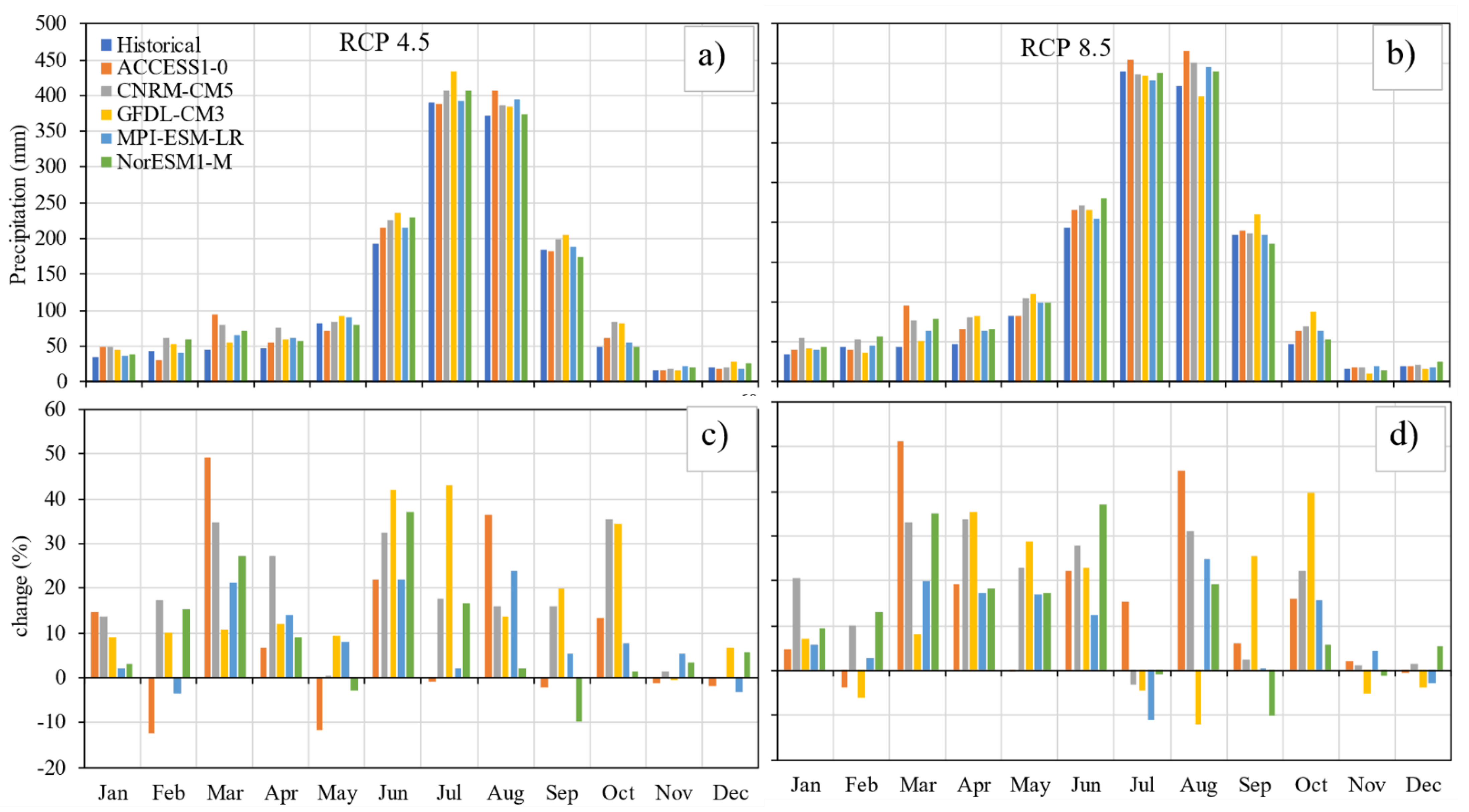
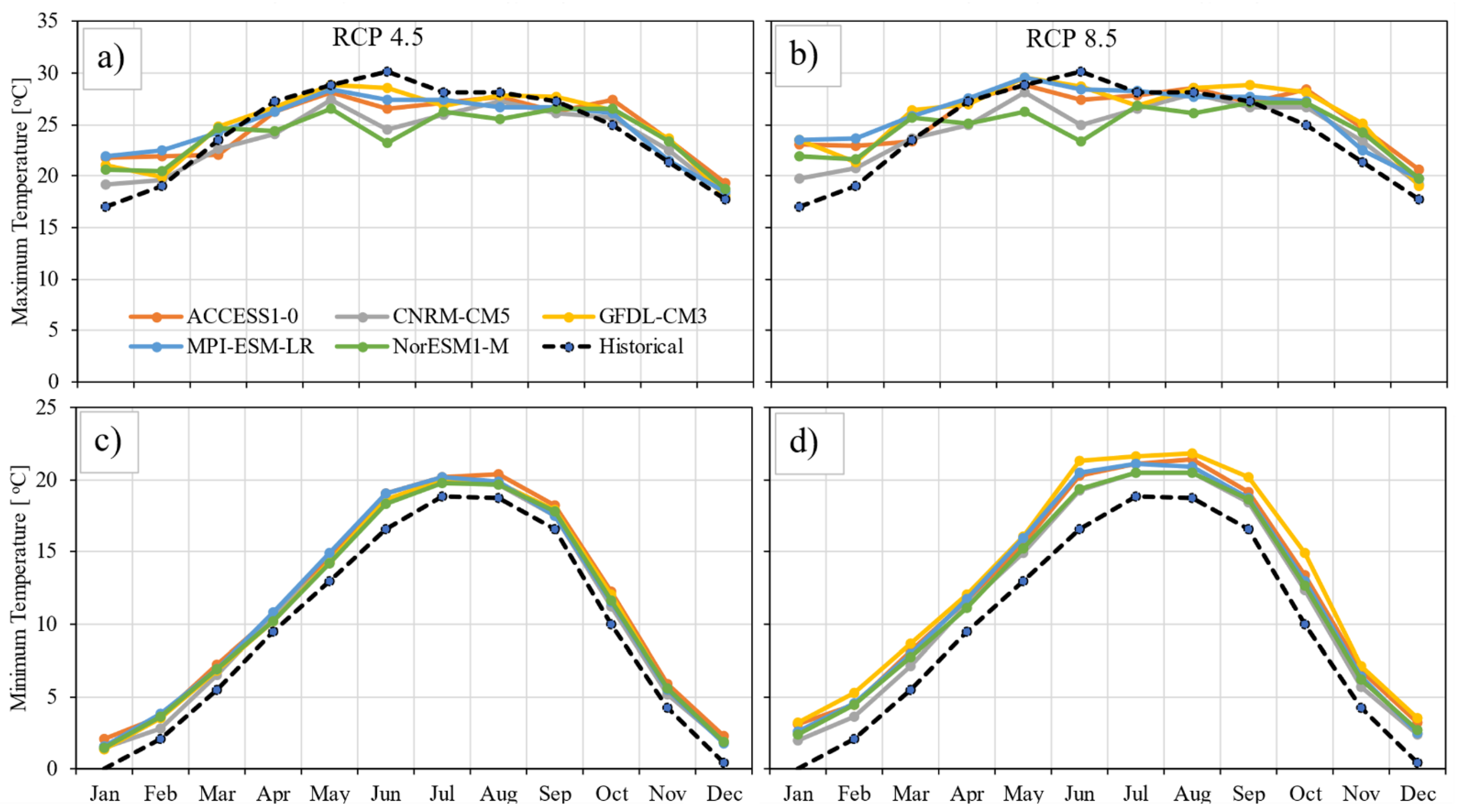
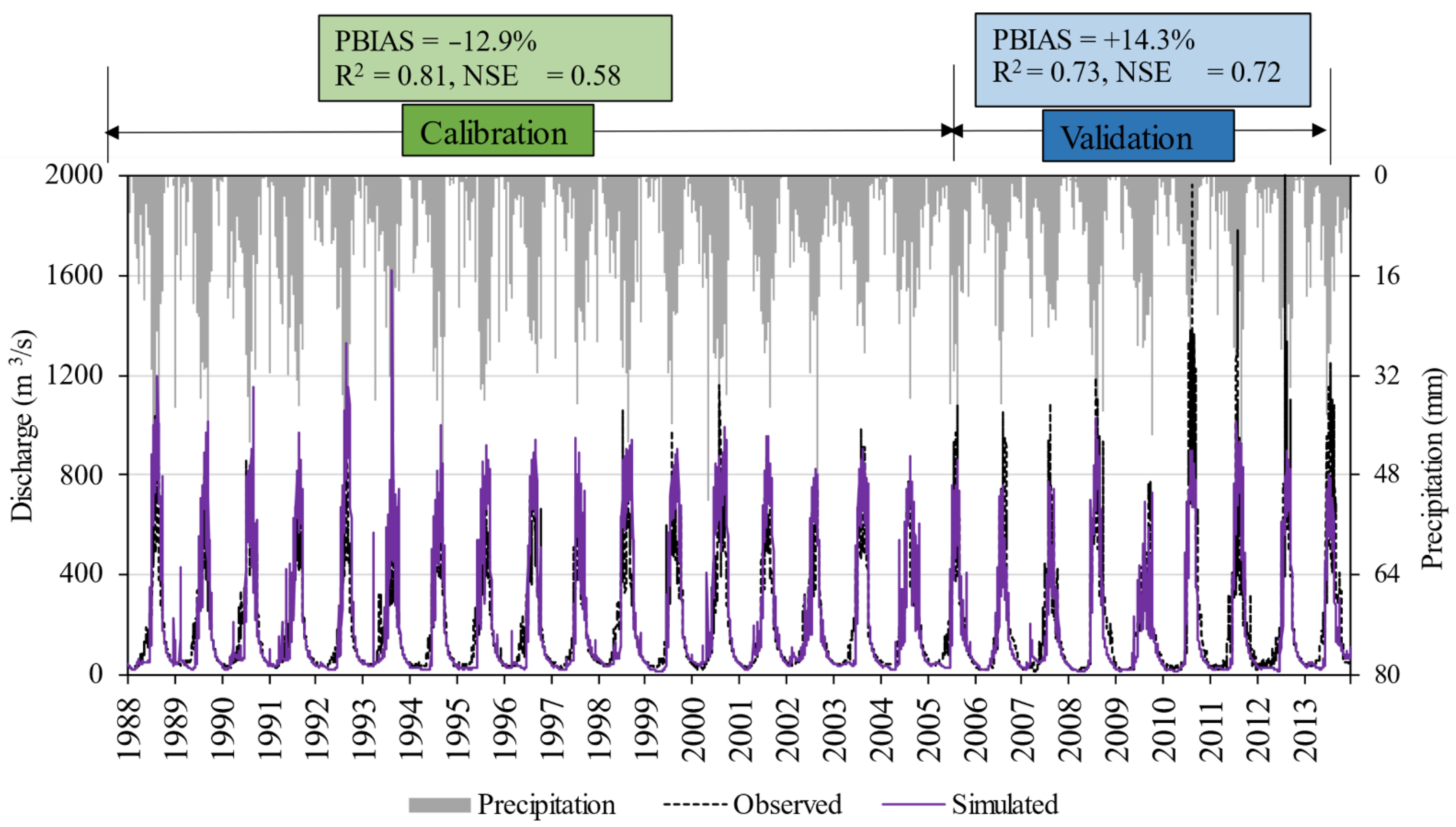
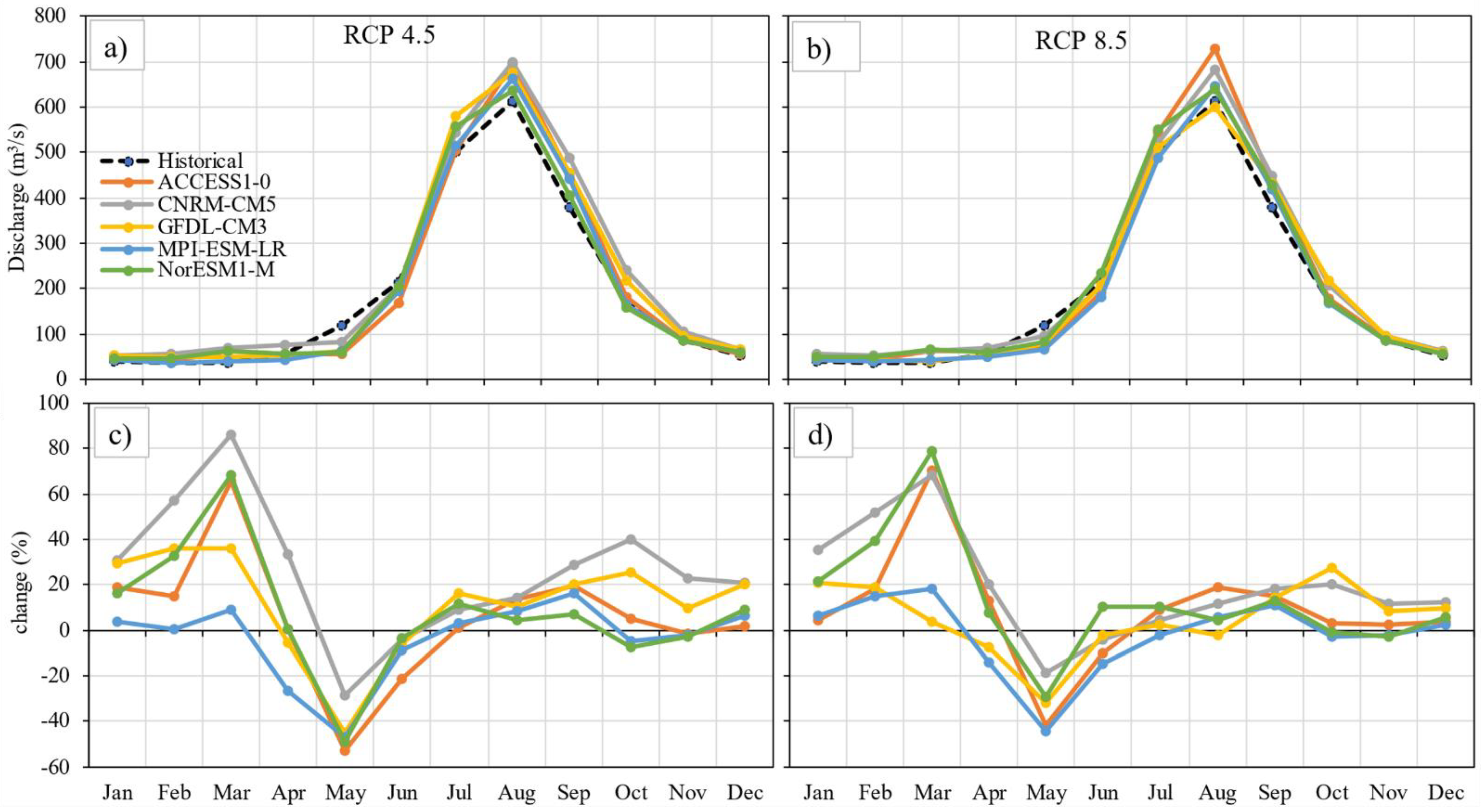
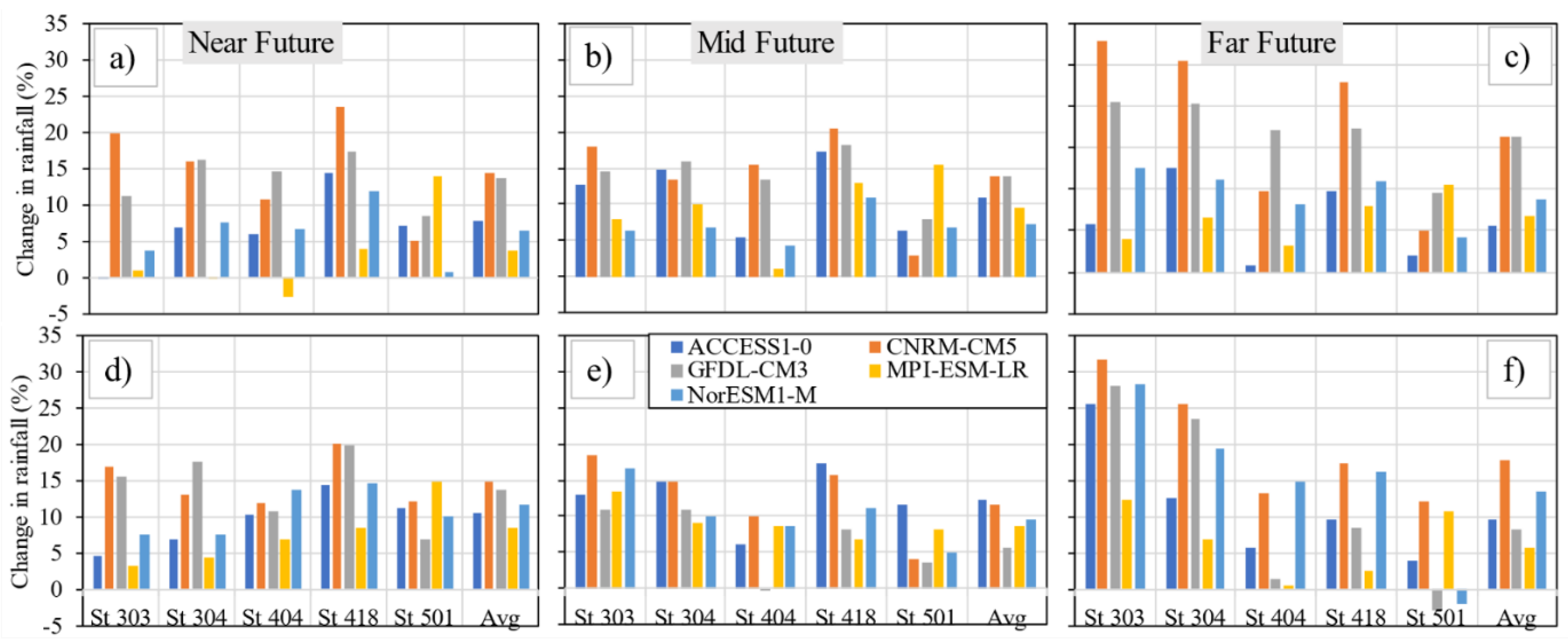



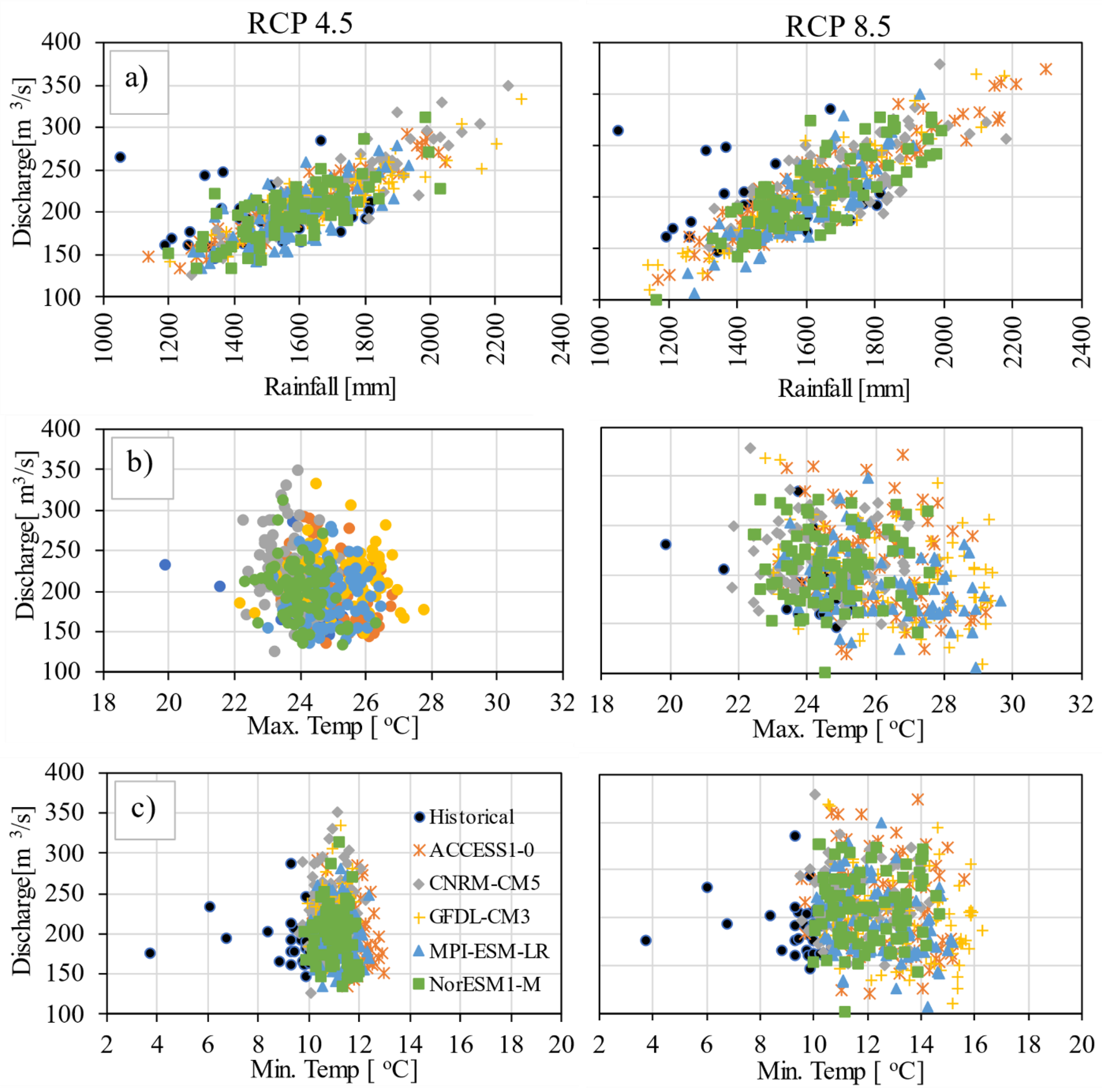
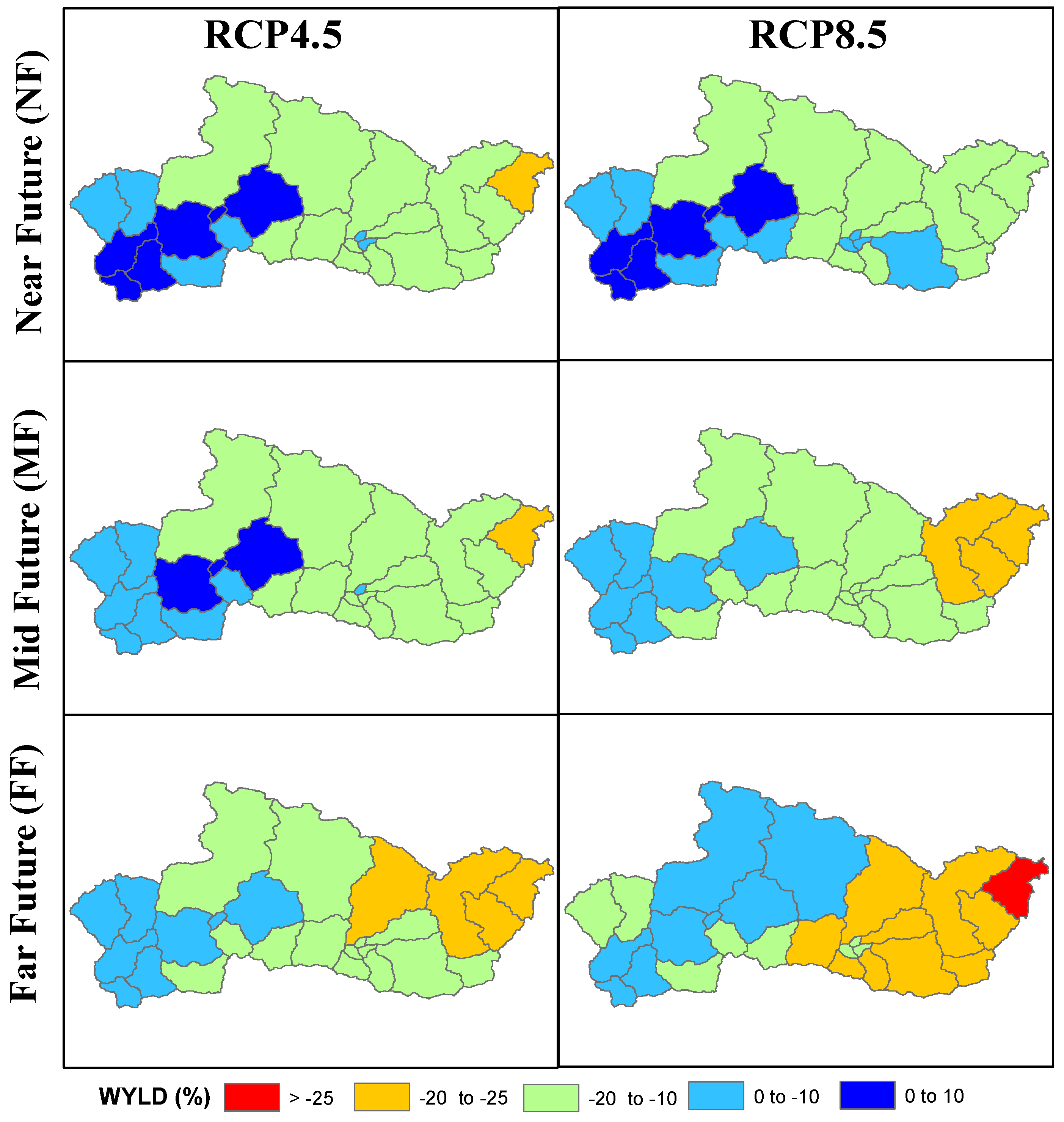
| SN | Data Type | Source | Characteristics | Reference | |
|---|---|---|---|---|---|
| Period | Spatial/Temporal Resolution | ||||
| 1 | Precipitation | DHM, Nepal | 1981–2014 | Daily | http://www.dhm.gov.np/ (accessed on 15 July 2018). |
| 2 | Temperature | ||||
| 3 | Solar Radiation | ||||
| 4 | Humidity | ||||
| 5 | Wind | ||||
| 6 | Streamflow | ||||
| 7 | Land use and Land cover | ICIMOD, Nepal | 2010 | 30 m × 30 m | [39] |
| 8 | Soil | SOTER-FAO | 2009 | 1:1 Million | [40] |
| 9 | Climate Models | CORDEX South Asia RCM Experiment | 1981–2100 | 0.5° × 0.5° | [4,38] http://cccr.tropmet.res.in (accessed on 10 December 2017). |
| ACCESS1-0, GFDL-CM3, CNRM-CM5, MPI-ESM-LR, NorESM1-M | Commonwealth Scientific and Industrial Research Organisation (CSIRO) | ||||
| 10 | Digital Elevation Model | SRTM | 2010 | 30 m × 30 m | |
| Climate Model | Statistical Indicator | Station 303 | Station 304 | Station 404 | Station 418 | Station 501 | |||||
|---|---|---|---|---|---|---|---|---|---|---|---|
| Raw | BC | Raw | BC | Raw | BC | Raw | BC | Raw | BC | ||
| ACCESS 1-0 | R2 | 0.4 | 0.5 | 0.3 | 0.5 | 0.3 | 0.6 | 0.4 | 0.6 | 0.4 | 0.6 |
| r | 0.6 | 0.7 | 0.5 | 0.7 | 0.6 | 0.7 | 0.6 | 0.8 | 0.6 | 0.7 | |
| Mean | 259.3 | 68.9 | 213.8 | 89.0 | 225.8 | 163.7 | 276.3 | 177.8 | 259.1 | 149.1 | |
| Stdev | 215.1 | 65.7 | 148.9 | 97.2 | 264.2 | 216.8 | 251.6 | 209.5 | 283.0 | 183.2 | |
| RMSE | 263.7 | 54.1 | 181.6 | 77.5 | 231.7 | 153.4 | 238.2 | 134.3 | 254.0 | 132.7 | |
| RSR | 1.2 | 0.8 | 1.2 | 0.8 | 0.9 | 0.7 | 0.9 | 0.6 | 0.9 | 0.7 | |
| CNRM-CM5 | R2 | 0.4 | 0.4 | 0.3 | 0.6 | 0.4 | 0.6 | 0.5 | 0.7 | 0.5 | 0.6 |
| r | 0.6 | 0.7 | 0.6 | 0.7 | 0.7 | 0.8 | 0.7 | 0.8 | 0.7 | 0.8 | |
| Mean | 239.4 | 68.9 | 198.0 | 89.1 | 231.1 | 163.4 | 270.0 | 177.8 | 261.6 | 149.2 | |
| Stdev | 209.1 | 66.8 | 150.0 | 96.2 | 266.9 | 210.6 | 257.9 | 206.2 | 295.6 | 180.1 | |
| RMSE | 245.6 | 56.0 | 165.6 | 72.2 | 212.2 | 139.7 | 229.0 | 123.6 | 239.5 | 124.2 | |
| RSR | 1.2 | 0.8 | 1.1 | 0.8 | 0.8 | 0.7 | 0.9 | 0.6 | 0.8 | 0.7 | |
| GFDL-CM3 | R2 | 0.3 | 0.6 | 0.3 | 0.5 | 0.4 | 0.6 | 0.5 | 0.5 | 0.4 | 0.6 |
| r | 0.6 | 0.7 | 0.6 | 0.7 | 0.7 | 0.8 | 0.7 | 0.7 | 0.7 | 0.8 | |
| Mean | 244.0 | 178.1 | 199.1 | 163.4 | 209.1 | 89.0 | 262.3 | 68.9 | 253.9 | 149.4 | |
| Stdev | 193.1 | 208.7 | 138.5 | 212.5 | 236.2 | 98.8 | 230.6 | 65.8 | 273.3 | 178.8 | |
| RMSE | 239.7 | 197.2 | 159.6 | 171.2 | 193.3 | 166.6 | 214.3 | 206.2 | 231.1 | 124.5 | |
| RSR | 1.2 | 0.9 | 1.2 | 0.8 | 0.8 | 1.7 | 0.9 | 3.1 | 0.8 | 0.7 | |
| MPI-ESM-LR | R2 | 0.3 | 0.5 | 0.3 | 0.6 | 0.5 | 0.6 | 0.5 | 0.5 | 0.4 | 0.6 |
| r | 0.6 | 0.7 | 0.6 | 0.8 | 0.7 | 0.8 | 0.7 | 0.7 | 0.7 | 0.8 | |
| Mean | 267.0 | 177.7 | 222.2 | 163.5 | 234.4 | 88.9 | 293.3 | 69.1 | 272.4 | 149.2 | |
| Stdev | 215.6 | 206.5 | 156.4 | 211.9 | 267.1 | 96.5 | 259.4 | 65.9 | 284.1 | 181.7 | |
| RMSE | 271.9 | 196.5 | 187.1 | 166.2 | 202.8 | 166.7 | 235.1 | 206.1 | 245.2 | 125.4 | |
| RSR | 1.3 | 1.0 | 1.2 | 0.8 | 0.8 | 1.7 | 0.9 | 3.1 | 0.9 | 0.7 | |
| NorESM1-M | R2 | 0.3 | 0.5 | 0.3 | 0.5 | 0.4 | 0.6 | 0.5 | 0.5 | 0.5 | 0.6 |
| r | 0.6 | 0.7 | 0.5 | 0.7 | 0.6 | 0.8 | 0.7 | 0.7 | 0.7 | 0.8 | |
| Mean | 267.4 | 177.7 | 220.2 | 163.1 | 231.8 | 89.1 | 285.4 | 69.1 | 267.7 | 149.1 | |
| Stdev | 210.7 | 206.0 | 156.5 | 211.0 | 271.0 | 95.8 | 256.5 | 66.4 | 284.6 | 180.8 | |
| RMSE | 268.5 | 195.8 | 190.0 | 168.1 | 221.2 | 167.6 | 252.5 | 206.7 | 239.2 | 118.2 | |
| RSR | 1.3 | 1.0 | 1.2 | 0.8 | 0.8 | 1.7 | 1.0 | 3.1 | 0.8 | 0.7 | |
| Station Name | RCP 4.5 | RCP 8.5 | Remarks | ||
|---|---|---|---|---|---|
| Maximum Change | Minimum Change | Maximum Change | Minimum Change | ||
| Station 303 | +44.9 mm (+89.6%) | −9.6 mm (−22.1%) | +15.1 mm (+97.5%) | −4.8 mm (−44.9%) | Precipitation |
| Station 304 | +37.7 mm (+91.1%) | −9.1 mm (−27.0%) | +12.3 mm (+112.7%) | −2.2 mm (−20.6%) | |
| Station 404 | +42.8 mm (+133.6%) | −17.6 mm (−41.9%) | +61.6 mm (+192.4%) | −5.1 mm (−36.0%) | |
| Station 418 | +72.7 mm (+149.9%) | −19.3 mm (−32.3%) | +70.3 mm (+144.8%) | −7.8 mm (−37.3%) | |
| Station 501 | +48.7 mm (+123.8%) | −5.7 mm (−32.1%) | +54.3 mm (+138.1%) | −7.5 mm (−42.6%) | |
| Station 303 | +5.9 °C (+39.6%) | −3.4 °C (−14.3%) | +7.3 °C (+53.6%) | −2.6 °C (−10.7%) | Maximum Temperature |
| Station 513 | +4.6 °C (+22.5%) | −11.1 °C (−32.2%) | +7.2 °C (+35.4%) | −11.1 °C (−32.2%) | |
| Station 303 | +3.7 °C (+20.8%) | +0.6 °C (+3.1%) | +5.8 °C (+30.7%) | +1.5 °C (+6.1%) | Minimum Temperature |
| Station 513 | +2.3 °C (+11.5%) | −0.4 °C (+1.3%) | +4.9 °C (+16.9%) | +1.1 °C (+4.0%) | |
| Parameter Name | Description | Fitted Value | Change Method |
|---|---|---|---|
| SOL_K | Saturated hydraulic conductivity (mm/h) | −0.1 | Multiply |
| CN2 | SCS runoff curve number | −0.38 | Multiply |
| SOL_AWC | Available water capacity of the soil layer (mm H2O/mm) | 0.06 | Multiply |
| GWQMN | Threshold depth of water in a shallow aquifer | 3500 | Replace |
| REVAPMN | Threshold depth if water in a shallow aquifer for revap | 30 | Replace |
| GW_REVAP | Groundwater revap coefficeient | 0.2 | Replace |
| RECHRG_DP | Deep aquifer percolation factor | 0.15 | Replace |
| GW_DELAY | Groundwater delay time (days) | 100 | Replace |
| ESCO | Soil evaporation compensation factor | 0.5 | Multiply |
| EPCO | Plant water uptake compensation factor | 0.3 | Replace |
| ALPHA_BF | Baseflow alpha factor | 0.08 | Replace |
| SURLAG | Surface runoff lag coefficient (days) | 2.5 | Replace |
| SNOCOVMX | Snow water equivalent to 100% snow cover (mm) | 93.03 | Replace |
| SNO50COV | Snow water equivalent to 50% snow cover (mm) | 0.62 | Replace |
| TLAPS | Temperatuure lapse rate (°C/km) | −6.3 | Replace |
| PLAPS | Rainfall lapse rate (mm/km) | −170 | Replace |
| SFTMP | Snowfall temperature [°C] | 1.0 | Replace |
| SMTMP | Snow melt base temperature [°C] | 0.5 | Replace |
| SMFMX | Melt factor for snow on June 21 [mm H2O/°C-day] | 4.5 | Replace |
| SMFMN | Melt factor for snow on December 21 [mm H2O/°C-day] | 4.5 | Replace |
| Climate Models | Precipitation-Streamflow | Tmax-Streamflow | Tmin-Streamflow | Emission Scenario | |||
|---|---|---|---|---|---|---|---|
| R2 | Reg. Equation | R2 | Reg. Equation | R2 | Reg. Equation | ||
| Observed | 0.006 | 0.0124x + 175.64 | 0.079 | −7.698x + 379.12 | 0.003 | −1.2092x + 203.34 | Historical |
| ACCESS1-0 | 0.863 | 0.1753x − 75.104 | 0.232 | −21.089x + 729.13 | 0.089 | −15.141x + 376.70 | RCP 4.5 |
| CNRM-CM5 | 0.776 | 0.1851x − 88.705 | 0.042 | −12.564x + 524.14 | 0.004 | −4.3053x + 273.13 | |
| GFDL-CM3 | 0.802 | 0.1506x − 39.548 | 5 × 10−5 | −0.226x + 220.55 | 0.006 | −5.2209x + 272.88 | |
| MPI-ESM-LR | 0.515 | 0.1573x − 52.339 | 0.002 | +1.965x + 147.37 | 0.005 | +4.0496x + 150.72 | |
| NorESM1-M | 0.529 | 0.1444x − 28.840 | 0.065 | −12.113x + 491.00 | 0.002 | −3.0306c + 233.68 | |
| ACCESS1-0 | 0.876 | 0.1656x − 62.265 | 0.078 | −8.4302x + 431.13 | 0.036 | −5.9331x + 285.90 | RCP 8.5 |
| CNRM-CM5 | 0.523 | 0.1405x − 22.635 | 0.012 | −3.243x + 294.35 | 0.000 | −0.3233x + 218.37 | |
| GFDL-CM3 | 0.842 | 0.1806x − 90.913 | 0.098 | −6.6536x + 375.23 | 0.089 | −7.0859x + 293.84 | |
| MPI-ESM-LR | 0.706 | 0.2083x − 137.99 | 0.135 | −8.3592x + 411.21 | 0.104 | −8.4461x + 297.08 | |
| NorESM1-M | 0.644 | 0.1649x − 61.762 | 0.002 | −1.1695x + 236.94 | 0.001 | +0.6096x + 200.59 | |
Publisher’s Note: MDPI stays neutral with regard to jurisdictional claims in published maps and institutional affiliations. |
© 2021 by the authors. Licensee MDPI, Basel, Switzerland. This article is an open access article distributed under the terms and conditions of the Creative Commons Attribution (CC BY) license (https://creativecommons.org/licenses/by/4.0/).
Share and Cite
Maharjan, M.; Aryal, A.; Talchabhadel, R.; Thapa, B.R. Impact of Climate Change on the Streamflow Modulated by Changes in Precipitation and Temperature in the North Latitude Watershed of Nepal. Hydrology 2021, 8, 117. https://doi.org/10.3390/hydrology8030117
Maharjan M, Aryal A, Talchabhadel R, Thapa BR. Impact of Climate Change on the Streamflow Modulated by Changes in Precipitation and Temperature in the North Latitude Watershed of Nepal. Hydrology. 2021; 8(3):117. https://doi.org/10.3390/hydrology8030117
Chicago/Turabian StyleMaharjan, Manisha, Anil Aryal, Rocky Talchabhadel, and Bhesh Raj Thapa. 2021. "Impact of Climate Change on the Streamflow Modulated by Changes in Precipitation and Temperature in the North Latitude Watershed of Nepal" Hydrology 8, no. 3: 117. https://doi.org/10.3390/hydrology8030117
APA StyleMaharjan, M., Aryal, A., Talchabhadel, R., & Thapa, B. R. (2021). Impact of Climate Change on the Streamflow Modulated by Changes in Precipitation and Temperature in the North Latitude Watershed of Nepal. Hydrology, 8(3), 117. https://doi.org/10.3390/hydrology8030117






